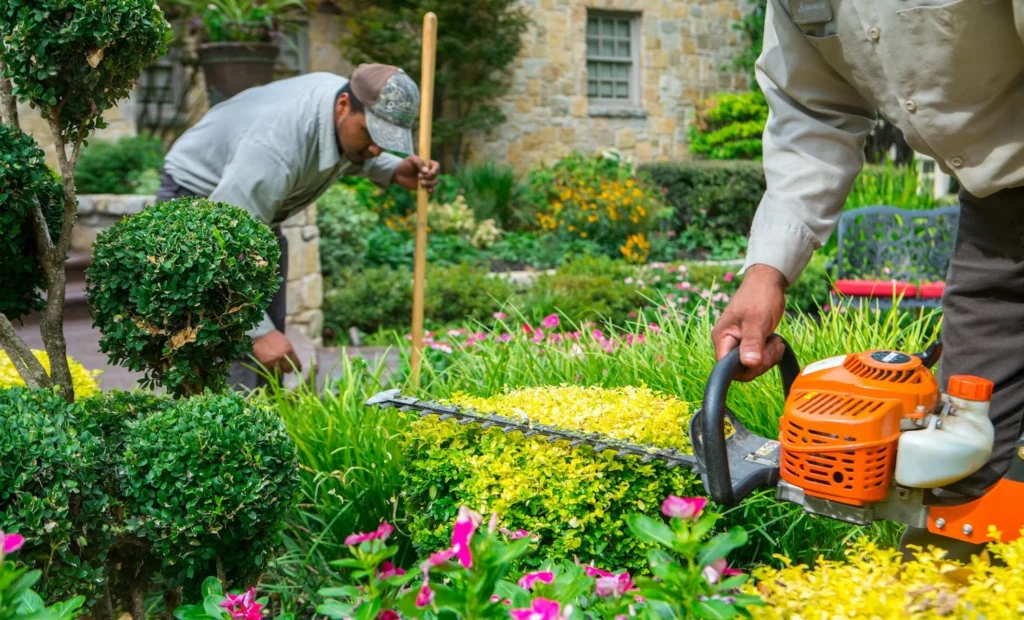Through careful planning and design, Land Scaping Service Keller TX can help mitigate the effects of temperature extremes, reduce reliance on mechanical heating and cooling systems, and ultimately lower energy consumption and utility costs.

Here’s a comprehensive guide on how landscaping can improve the energy efficiency of a home:
- Strategic Tree Planting: Trees are one of the most effective elements of landscaping for improving energy efficiency. By strategically planting trees in locations that provide shade to the home during the hottest parts of the day, you can reduce solar heat gain through windows and walls. Deciduous trees, which shed their leaves in the winter, provide shade during the summer while allowing sunlight to penetrate during the winter, maximizing their energy-saving benefits year-round. Plant trees on the west and east sides of the house to block the low-angle afternoon and morning sun, respectively.
- Shrubbery and Groundcovers: In addition to trees, shrubs and groundcovers can also provide shade and insulation to the home. Planting shrubs and groundcovers around the perimeter of the house can help reduce heat absorption from the ground and minimize heat transfer through walls and foundations. Choose dense, evergreen shrubs to provide year-round insulation and windbreaks, particularly on the north side of the house to shield against cold winter winds.
- Creating Windbreaks: Strategic placement of trees and shrubs can create natural windbreaks that help reduce heat loss from the home during the winter. Planting dense evergreen trees or shrubs on the north and northwest sides of the house can block cold winter winds, reducing the need for heating and improving comfort indoors. Windbreaks also help reduce air infiltration and drafts, enhancing the efficiency of heating systems.
- Installing Hardscape Features: Hardscape features such as walls, fences, and trellises can help modify microclimates around the home, providing additional insulation and reducing heat gain or loss. Use materials with high thermal mass, such as stone or brick, for hardscape features to absorb and release heat slowly, moderating temperature fluctuations indoors. Consider incorporating climbing vines or ivy on trellises to provide additional shade and insulation to walls during the summer months.
- Creating Outdoor Living Spaces: Designing outdoor living spaces such as patios, decks, and pergolas can extend the usable living area of the home while reducing the need for indoor heating and cooling. Outdoor spaces shaded by trees, pergolas, or retractable awnings can provide comfortable areas for relaxation and entertainment during hot weather, reducing reliance on air conditioning. Use permeable paving materials such as gravel or pavers for outdoor surfaces to reduce heat absorption and promote natural drainage.
- Optimizing Water Features: Incorporating water features such as ponds, fountains, or birdbaths into the landscape can have a cooling effect on the surrounding area through evaporation. Position water features in areas where prevailing winds can carry evaporated moisture toward the home, providing natural cooling during hot weather. Additionally, aquatic plants and vegetation around water features can further enhance cooling effects and contribute to biodiversity in the landscape.
- Implementing Green Roofs and Walls: Green roofs and walls, also known as living roofs and walls, involve covering roof or wall surfaces with vegetation to provide insulation, reduce heat gain, and improve air quality. Green roofs and walls can significantly reduce energy consumption by insulating the building envelope, absorbing solar radiation, and mitigating urban heat island effects. Choose drought-tolerant plants and lightweight growing media for green roofs and walls to minimize maintenance and structural load.
- Promoting Natural Ventilation: Landscaping can be used to promote natural ventilation and airflow around the home, reducing the need for mechanical cooling systems. Planting trees and shrubs strategically to channel prevailing winds toward windows and openings can facilitate cross-ventilation and improve indoor air quality. Design outdoor spaces with open-air features such as pergolas, arbors, or lattice screens to encourage airflow and create comfortable microclimates.
- Reducing Irrigation Water Demand: Selecting drought-tolerant plants and native species for landscaping can reduce the demand for irrigation water, conserving resources and lowering utility costs. Use mulch around plants to retain soil moisture, suppress weed growth, and regulate soil temperature, reducing the need for frequent watering. Install efficient irrigation systems such as drip irrigation or soaker hoses to deliver water directly to the root zone of plants, minimizing water waste through evaporation and runoff.
- Maintaining Landscaping: Regular maintenance of landscaping features is essential to ensure their continued effectiveness in improving energy efficiency. Prune trees and shrubs regularly to maintain their shape and promote healthy growth, removing any dead or diseased branches that could obstruct airflow or impede sunlight. Monitor irrigation systems for leaks and adjust watering schedules seasonally to match plant needs and weather conditions. Inspect hardscape features for cracks or damage and repair as needed to prevent heat loss or moisture infiltration.
Land Scaping Service Keller TX With careful planning, design, and maintenance, landscaping can transform outdoor spaces into functional, beautiful, and energy-efficient environments that complement and enhance the home.
Green Earth Services
1110-1130 Mossy Rock Dr, Keller, TX 76248, United States
1-817-966-5292
https://maps.app.goo.gl/7GipKvmBaWW6KQ2HA
Leave a Reply